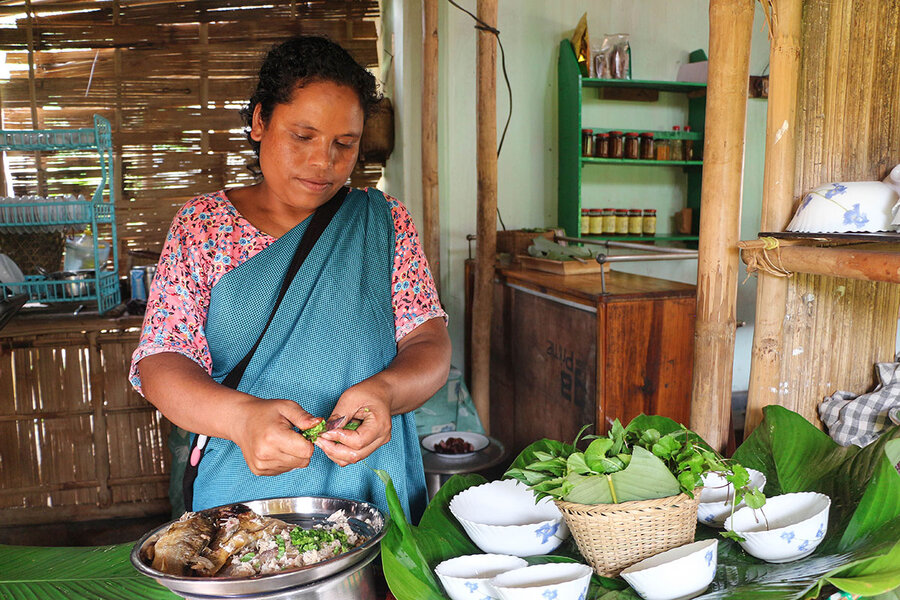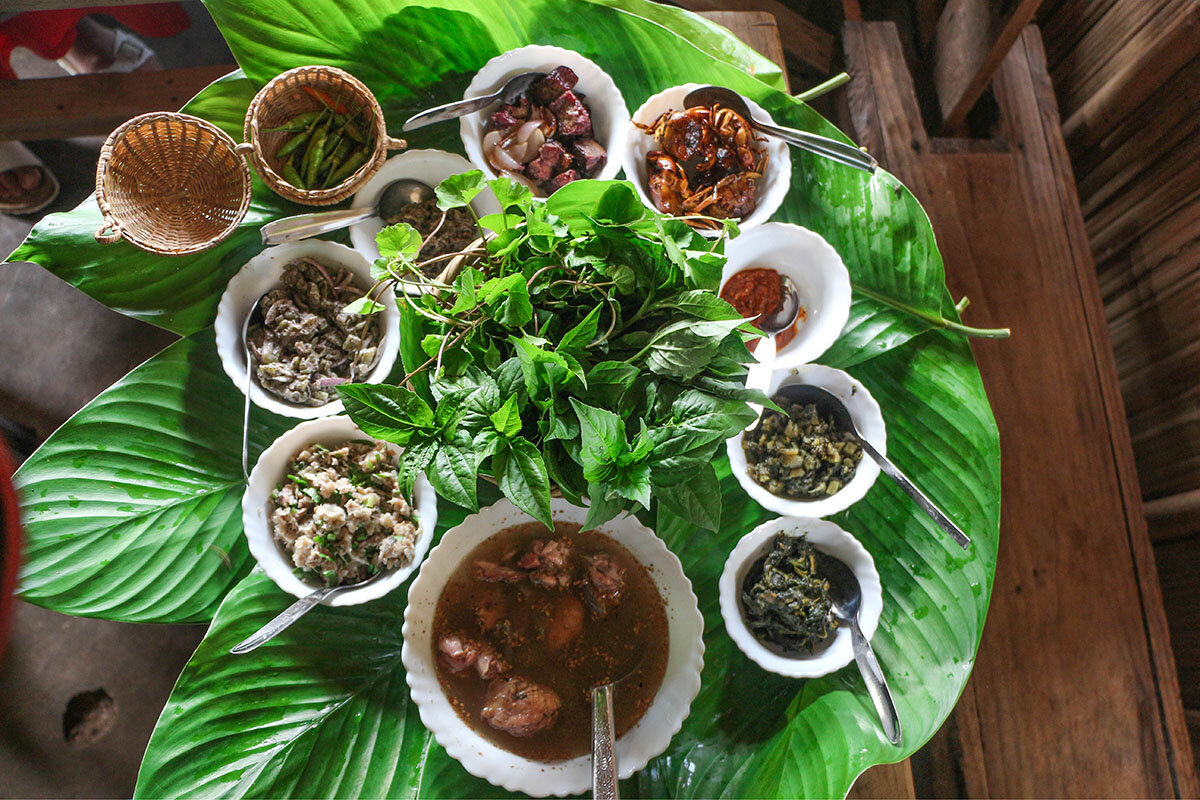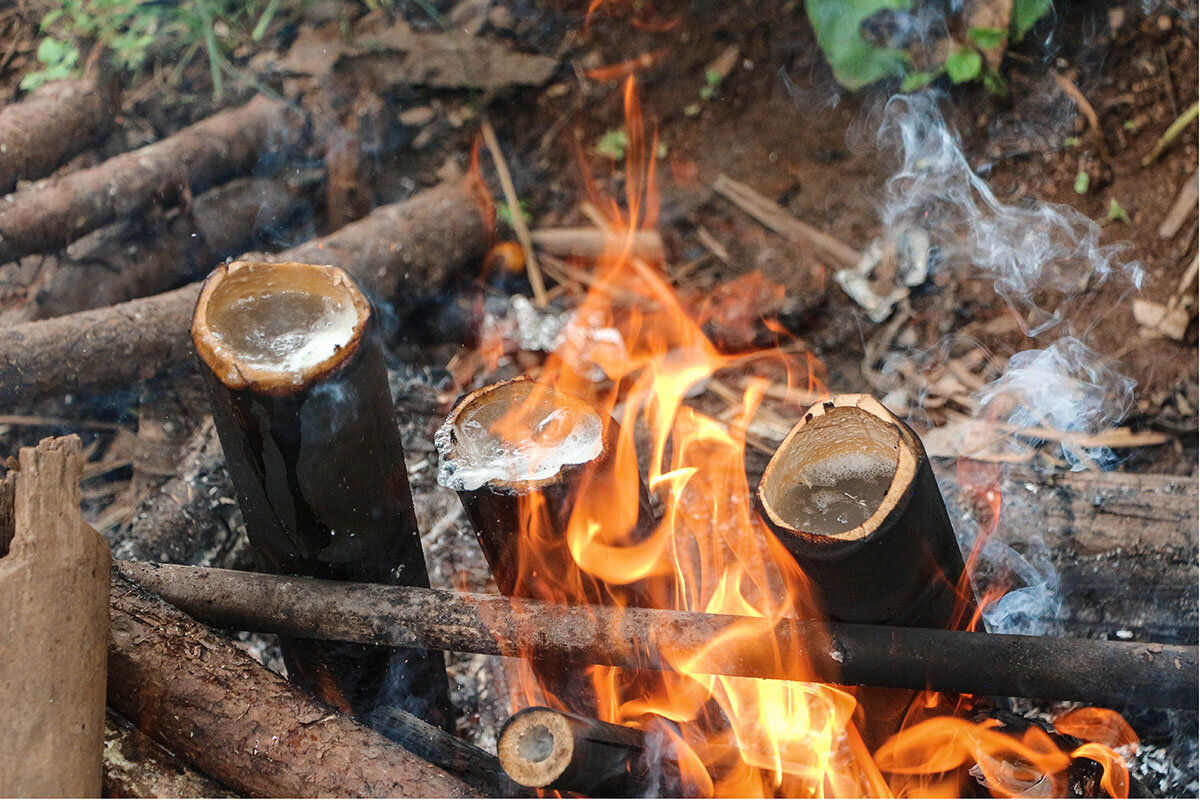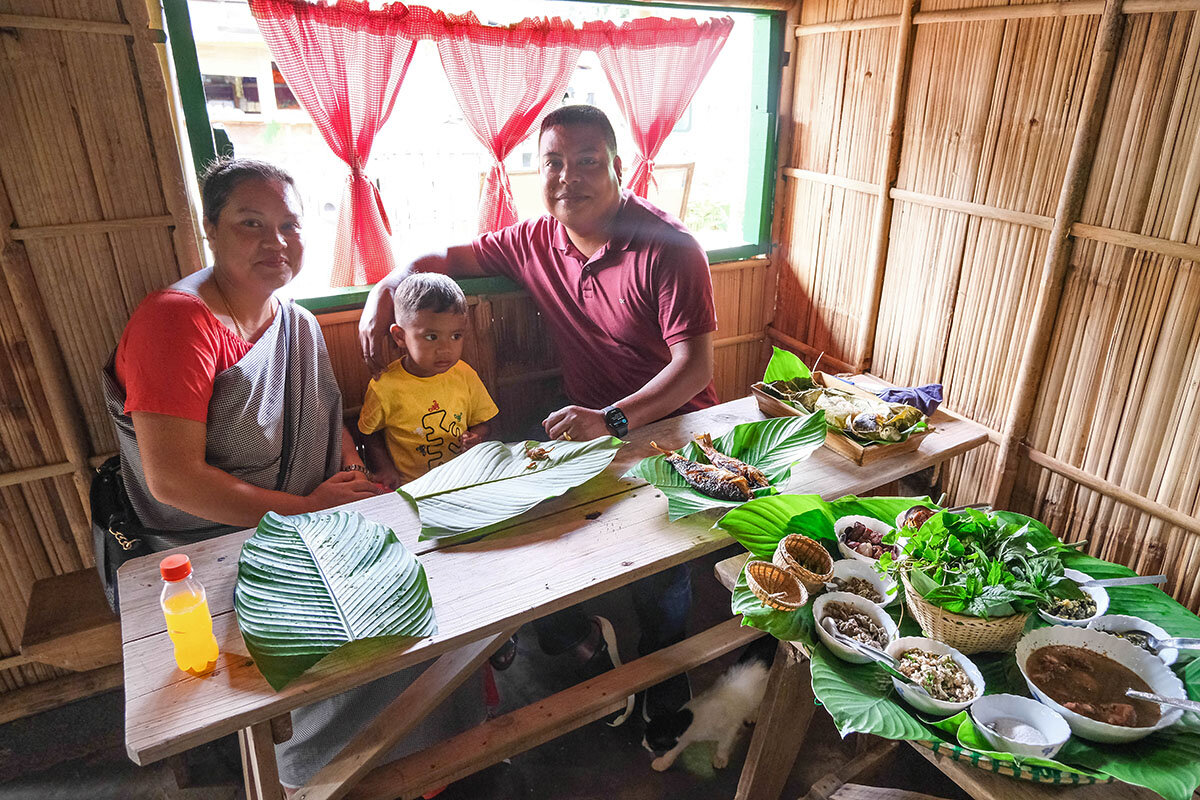Foraged feasts: India’s ‘Mother Earth’ cafes promote resilient foodways
Loading...
| Khweng, India
It’s 2 in the afternoon and Dial Muktieh is rustling up a feast for her customers. River fish cooks in a bamboo hollow as charred skies bring scattered rains outside. A mother digs into a plate of native rice with tham – a condiment prepared with crabs found in the rice paddies, fermented fish, and prickly ash from the back garden – while a farmer rests on a low bench and sips a cup of tea with ja shulia, sticky rice cooked in a bottle gourd and served wrapped in a green leaf.
Welcome to Mei-Ramew Cafe.
Here, in a small village in India’s northeastern state of Meghalaya, Kong Dial – as she’s respectfully known among her customers and community, with kong meaning “sister” in the local Khasi language – serves the native food of the Bhoi people, a subgroup of the Indigenous Khasi people, the state’s largest community.
Why We Wrote This
A story focused onIn northeast India, “Mother Earth” cafes are helping revive Meghalaya’s Indigenous cuisine. They’re part of a statewide movement aiming to not only safeguard Indigenous knowledge and native plant life, but also boost food security and nutrition in the region.
Kong Dial and her cafe are part of a statewide movement to revive Indigenous foodways throughout Meghalaya. Advocates encourage businesses to use local, seasonal, and wild-grown ingredients, and tap into ancestral farming and foraging techniques. It also involves protecting Meghalaya’s rich biodiversity through seed banks, and families growing near-extinct plants in their backyards.
Safeguarding Indigenous knowledge and native plant life may be reason enough to rethink dinner, but experts also say localizing foodways can boost food security and nutrition. While people in cities found it difficult to access fresh foods during the pandemic, villagers in Khweng faced fewer issues, as they could rely in part on their environment, explains senior agriculturist Redian Syiem.
“Tell me, what do you want to become? Do you want to be rich? Have so much money but no access to food when there’s a crisis like COVID-19?” Kong Redian asks. “Or do you want to have enough food to sustain yourself?”
To her, preserving native biodiversity is a matter of self-sufficiency.
“When you can find everything to eat from your backyard, the paddy fields, these water streams, and the forest, there’s no need to buy food at the market,” Kong Redian says, sitting beside a tray of cultivated and wild-grown greens inside Kong Dial’s cafe.
Losing local taste
An influx of business and tourism from other states has pushed Meghalaya restaurants to cater to mainland Indian palates, and over time, experts say those influences have crept into local homes as well. When people cooked white rice, dal, and market-bought vegetables, they forgot the native ingredients that once defined Meghalaya cuisine.
“Meghalaya is home to several Indigenous groups, but we now cook food like those from the metro cities in India,” says Rundolf Mawlieh, content consultant at the North East Slow Food and Agrobiodiversity Society (NESFAS), a nonprofit promoting environmentally friendly local food traditions and agricultural biodiversity.
“For example, we made palak paneer yesterday,” says Mr. Mawlieh, chuckling. “We also grew up watching MTV, so there’s a huge influence of Western culture. If we go to a restaurant, we would order a burger.”
This dependency on commercially produced foods not only has a high carbon footprint, but also makes communities vulnerable to hunger and malnutrition. The World Food Program has declared 2022 the “year of unprecedented hunger,” as a combination of COVID-19, climate change, and rising food costs has pushed “828 million people to go to bed hungry every day.”
A quarter of the world’s undernourished people live in India, where rural food prices have doubled this past year.
Turning to traditional foodways can improve diets and help protect communities from economic and environmental disasters.
“Traditional and diversified food systems are more resilient to changing climate compared to vulnerable monoculture farming we use today,” says transdisciplinary food system researcher Lukas Pawera, whose 2021 research found that only about a third of tribal women in Meghalaya consumed a diverse diet despite the region’s rich food resources.
Mother Earth
In Khweng alone, NESFAS has documented 319 edible plant varieties, but researchers rarely saw people eating them. “There was a strong notion that wild greens were poor man’s food,” says Janak Preet Singh, senior associate of livelihood initiatives at NESFAS.
So NESFAS came up with the idea of Mei-Ramew (or “Mother Earth”) cafes, which would help preserve “age-old foraging knowledge” and “encourage entrepreneurship” while breaking stigmas around local food, Mr. Singh says.
When they pitched it to local food vendors nearly 10 years ago, Plantina Kharmujai was the only person who agreed to rework her menu with the Indigenous recipes she learned from her grandmother.
Kong Plantina established the state’s first Mei-Ramew cafe in 2013 with the guidance of NESFAS. Since then, she’s trained other cooks including Kong Dial, who opened her cafe opposite Kong Plantina’s in 2019.
There are now three Mei-Ramew cafes in Meghalaya supported by NESFAS, and several other independent eateries promoting native cuisines scattered across the state.
No longer “poor man’s food”
Mei-Ramew cafe owners say word-of-mouth and recent media exposure has helped their popularity grow. For some customers, this is their first time trying Indigenous cuisine, but for others, it’s the taste of home.
Sagar W. Pakyntein describes it as “the food of my grandparents.” Whenever he’s free, the police subinspector drives over 10 miles to visit the Mei-Ramew cafes in Khweng.
“When I want to eat out, I don’t go to a pizza joint in the city,” Mr. Pakyntein says, digging into khaw lakang, local rice cooked in a bamboo tube with kharang, smoked fish. “I come here with my 3-year-old son. It’s important we teach our younger generations about our own food so that we can preserve this knowledge.”
At her previous stall, Kong Dial prepared mainland Indian snacks like samosa, but she’s garnered more attention for her traditional dishes at the Mei-Ramew Cafe. Customers “loved my Bhoi food and encouraged me to do more,” Kong Dial says.
“This shows the mindset change. She’s changing the image people have about eating local, foraged food,” says Mr. Mawlieh, from NESFAS.
There’s also room for innovation. Kong Plantina is using her ancestral knowledge to come up with new, fun recipes like ruby-pink popsicles made with the extract of roselle flowers she grows in the backyard.
But the movement goes beyond the Mei-Ramew cafes.
NESFAS also conducts farmers markets where people can buy local produce and support cultivators. Seed banks have been set up to ensure native plants survive and thrive, and local entrepreneurs like Gerald Duia, founder of Duia Trailblazers, conduct eco-tours where tourists can experience how tribal communities eat.
“No matter how modern we are, we all need food to survive, and food comes from the earth,” says Mr. Duia. “It’s important to know what we can eat and what nutritional value they have. We need to keep learning and pass our knowledge on to the next generations.”








